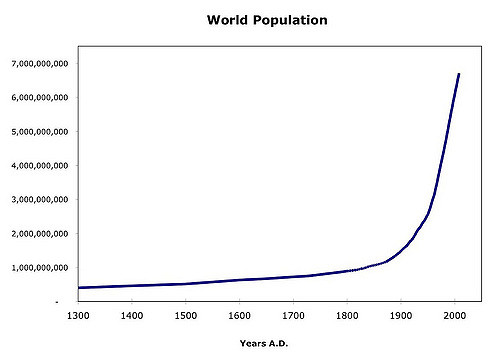Occasionally you will find types of math that are not used very often, but are essential when they are. Exponential growth and decay are two examples of this. The odds of you using them on your next trip to the supermarket are fairly slim (more on using odds later), but some professions simply would not be able to do the things they do without them.
To get an idea of what a graph of exponential growth looks like, consider the following graph of the global human population:
Notice how it isn’t just increasing, but is increasing at a progressively greater rate? This is what is meant by exponential growth. If this graph were to be flipped the other direction so that the decrease starts steep but levels out as it approaches zero, that would be exponential decay.
Hopefully as you read these examples, your passion for this math topic will grow exponentially. I hope your interest won’t decay as the conversation goes on. [Editor’s Note: I know the puns are bad, and I’m not sorry. You knew what you were getting into when you read a blog by a math teacher.] Here are a few key uses for these concepts:
- Radioactive half-life: As radioactive material decays, it does so exponentially. For example, if you have a 100 g of a radioactive material that has a half-life of 5 minutes, after five minutes you’d have 50 g. After another five minutes (so 10 total), you’d have 25 g left, and so on.
- This is vitally important to fields such as archeology because of a process called carbon dating. Carbon dating works by tracking how much carbon-14 has decayed into nitrogen-14 and using the half-life to see how long it would take to do so.
- Nuclear engineers also need to account for radioactive half-life when designing storage containers for the waste created by nuclear energy.
- Medical professionals use technetium-99m in imaging tests by tracking the radiation before it completely decays. This requires them to know the half-life of technetium-99m so that they know the time-window they have to run the test before the material decays away.
- Compound interest: Either your best friend or your worst enemy, compound interest forms a cornerstone of the modern financial system. While simple interest adds a percentage of the principal amount every time, compound interest adds a percentage of the principal amount, but then adds a percentage of that new amount. If the compound interest is applying to your investments, that’s good news! Things aren’t so rosy when it is applying to your debts. As the population graph above shows, things can get out of control fairly quickly if you aren’t careful. Luckily, you can now use your interest in exponential growth to help interest work for you and not against you.
- Population growth: As the Commonwealth of Australia could tell you, rabbits with food and without predators reproduce quickly. Exponentially, in fact. All populations will reproduce exponentially until they approach the carrying capacity of the area, or the maximum number the area can support sustainably. Basically, as long as they have food, water, and are free from disease or predators, life will continue to increase in large numbers.
- The growing human population, shown in that graph above, is an interest to anthropologists, who study the history of human civilization. Political scientists (and other policy makers) use it to predict population growth in the future, and how that will affect supplies. Currently, the carrying capacity of the world’s human population is not known and is a topic of debate. One organization polled scientists and found that carrying capacity estimates ranged from 500 million to 1 sextillion, depending on how well you assumed people wanted to live.
- Biologists also look at population growth for everything from rabbits in Australia to bacteria in a Petri dish. Things reproduce, and math helps to predict how often.
While not the most commonly used tools in algebra, many fields simply wouldn’t be possible without these functions. Hopefully your love of them grew exponentially as you learned about their use. [Editor’s Note: Essentially the same bad pun twice? I’ll apologize for the lack of creativity, but not the joke!]

